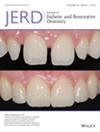Management of hyperplastic tissue response following connective tissue grafting
Abstract
Objective
While connective tissue graft shrinkage is a well-documented post-transplantation reaction, there is a literature gap concerning hyperplastic tissue response. Despite its infrequent occurrence, investigation is warranted due to its capacity to compromise esthetics, disrupt lip dynamics, and promote food retention. Moreover, efforts to mitigate hyperplastic tissue response often prove challenging, and there is a potential risk of exacerbating gingival tissue rebound.
Clinical Considerations
This report presents a potential solution to managing tissue overgrowth after connective tissue grafting in five clinical cases. The patients underwent corrective surgery involving internal excision of excessive tissue while preserving the overlying mucosa. The surgical approach was tailored to excise hyperplastic tissue with minimal trauma, aiming to optimize esthetic outcomes. Subsequent follow-up assessments spanning 1–5 years demonstrated stable results, with no indications of relapse or recurrence of tissue overgrowth.
Conclusions
Within the limitations of this case series, surgical internal excision holds promise as a viable treatment modality for addressing post-transplantation hyperplastic tissue response.
Clinical Significance
This case series addresses the challenge of uncontrolled tissue overgrowth following connective tissue grafting, a concern for which previous attempts have proven unsuccessful. Internal in-toto excision emerges as a promising approach for effectively eliminating overgrown tissue, offering potential advancements in the clinical management of this complication.

 求助内容:
求助内容: 应助结果提醒方式:
应助结果提醒方式:


